How to install Elxis CMS 4.6 on Centos 7.5
- 00:56 cat /etc/centos-release
- 01:08 yum install httpd mariadb-server -y
- 01:26 systemctl enable httpd mariadb
- 01:35 systemctl start httpd mariadb
- 01:44 systemctl status httpd mariadb
- 02:03 mysql_secure_installation
- 02:39 mysql -u root -p
- 03:01 create database elxis;
- 03:30 create user user@localhost identified by 'linuxc';
- 03:42 grant all on elxis.* to user@localhost;
- 03:50 flush privileges;
- 04:20 yum install epel-release yum-utils -y
- 04:35 rpm -Uvh https://mirror.webtatic.com/yum/el7/webtatic-release.rpm
- 04:47 wget http://rpms.remirepo.net/enterprise/remi-release-7.rpm
- 05:02 rpm -Uvh remi-release 7.rpm
- 05:19 yum-config-manager --enable remi-php71
- 06:00 vim /etc/php.ini
- 06:07 date.timezone= Asia/Kolkata
- 07:18 unzip elxis_4.6_phaethon_rev1958.zip
- 07:40 chmod -R 775 elxis/
- 07:56 vim /etc/httpd/conf.d/b2.conf
- 08:21 vim /etc/hosts
Installation Of Elxis CMS 4.6 On Centos 7.5
Features
Multi-level menus,
Image galleries,
Powerful Templating System,
Extensible search System.
Pre-requisites
Centos-7.5
Apache 2.4
MariaDB 5.5
PHP 7.1
To Check the Version of Centos:
[root@linuxhelp ~]# cat /etc/centos-release
CentOS Linux release 7.5.1804 (Core)
LAMP Stack Installation Procedure:
Install Apache And MariaDB Server into the system.
[root@linuxhelp ~]# yum install httpd mariadb-server -y
Loaded plugins: fastestmirror, langpacks
Loading mirror speeds from cached hostfile
* base: mirror.nbrc.ac.in
* extras: mirror.ehost.vn
* updates: mirror.nbrc.ac.in
Resolving Dependencies
--> Running transaction check
---> Package httpd.x86_64 0:2.4.6-88.el7.centos will be installed
.
.
.
Installed:
httpd.x86_64 0:2.4.6-88.el7.centos mariadb-server.x86_64 1:5.5.60-1.el7_5
Dependency Installed:
apr.x86_64 0:1.4.8-3.el7_4.1 apr-util.x86_64 0:1.5.2-6.el7 httpd-tools.x86_64 0:2.4.6-88.el7.centos
mailcap.noarch 0:2.1.41-2.el7 mariadb.x86_64 1:5.5.60-1.el7_5 perl-DBD-MySQL.x86_64 0:4.023-6.el7
Dependency Updated:
mariadb-libs.x86_64 1:5.5.60-1.el7_5
After Successful Installation of Apache And MariaDB Servers, Now do Enable and Start the service of both Apache And MariaDB.
[root@linuxhelp ~]# systemctl enable httpd mariadb
Created symlink from /etc/systemd/system/multi-user.target.wants/httpd.service to /usr/lib/systemd/system/httpd.service.
Created symlink from /etc/systemd/system/multi-user.target.wants/mariadb.service to /usr/lib/systemd/system/mariadb.service.
[root@linuxhelp ~]# systemctl start httpd mariadb
Check the status of Apache And MariaDB by executing the following command.
[root@linuxhelp ~]# systemctl status httpd mariadb
● httpd.service - The Apache HTTP Server
Loaded: loaded (/usr/lib/systemd/system/httpd.service; enabled; vendor preset: disabled)
Active: active (running) since Thu 2019-03-28 13:15:25 IST; 34s ago
`
`
● mariadb.service - MariaDB database server
Loaded: loaded (/usr/lib/systemd/system/mariadb.service; enabled; vendor preset: disabled)
Active: active (running) since Thu 2019-03-28 13:15:28 IST; 30s ago
Secure MariaDB by setting the root password with the following installation .
[root@linuxhelp ~]# mysql_secure_installation
NOTE: RUNNING ALL PARTS OF THIS SCRIPT IS RECOMMENDED FOR ALL MariaDB
SERVERS IN PRODUCTION USE! PLEASE READ EACH STEP CAREFULLY!
In order to log into MariaDB to secure it, we'll need the current
password for the root user. If you've just installed MariaDB, and
you haven't set the root password yet, the password will be blank,
so you should just press enter here.
Enter current password for root (enter for none):
OK, successfully used password, moving on...
Setting the root password ensures that nobody can log into the MariaDB
root user without the proper authorisation.
Set root password? [Y/n] y
New password:
Re-enter new password:
Password updated successfully!
Reloading privilege tables..
... Success!
By default, a MariaDB installation has an anonymous user, allowing anyone
to log into MariaDB without having to have a user account created for
them. This is intended only for testing, and to make the installation
go a bit smoother. You should remove them before moving into a
production environment.
Remove anonymous users? [Y/n] y
... Success!
Normally, root should only be allowed to connect from 'localhost'. This
ensures that someone cannot guess at the root password from the network.
Disallow root login remotely? [Y/n] y
... Success!
By default, MariaDB comes with a database named 'test' that anyone can
access. This is also intended only for testing, and should be removed
before moving into a production environment.
Remove test database and access to it? [Y/n] y
- Dropping test database...
... Success!
- Removing privileges on test database...
... Success!
Reloading the privilege tables will ensure that all changes made so far
will take effect immediately.
Reload privilege tables now? [Y/n] y
... Success!
Cleaning up...
All done! If you've completed all of the above steps, your MariaDB
installation should now be secure.
Thanks for using MariaDB!
Create new database for elxis CMS and set permissions to a particular user to access the elxis database with a password .
[root@linuxhelp ~]# mysql -u root -p
Enter password:
Welcome to the MariaDB monitor. Commands end with ; or \g.
Your MariaDB connection id is 10
Server version: 5.5.60-MariaDB MariaDB Server
Copyright (c) 2000, 2018, Oracle, MariaDB Corporation Ab and others.
Type 'help;' or '\h' for help. Type '\c' to clear the current input statement.
MariaDB [(none)]> show databases;
+--------------------+
| Database |
+--------------------+
| information_schema |
| mysql |
| performance_schema |
+--------------------+
3 rows in set (0.00 sec)
MariaDB [(none)]> create database elxis character set utf8mb4;
Query OK, 1 row affected (0.00 sec)
MariaDB [(none)]> use elxis;
Database changed
MariaDB [elxis]> create user user@localhost identified by 'linuxc';
Query OK, 0 rows affected (0.00 sec)
MariaDB [elxis]> grant all on elxis.* to user@localhost;
Query OK, 0 rows affected (0.00 sec)
MariaDB [elxis]> flush privileges;
Query OK, 0 rows affected (0.00 sec)
MariaDB [elxis]> exit
Bye
PHP Installation Procedure :
To install PHP,we need to install 3 third-party yum repositories which are epel-release,webtatic and remi-release.
Install the epel-release repository with the following command.
[root@linuxhelp ~]# yum install epel-release yum-utils -y
Loaded plugins: fastestmirror, langpacks
Loading mirror speeds from cached hostfile
* base: mirror.nbrc.ac.in
* extras: mirror.ehost.vn
* updates: mirror.nbrc.ac.in
Resolving Dependencies
--> Running transaction check
---> Package epel-release.noarch 0:7-11 will be installed
---> Package yum-utils.noarch 0:1.1.31-45.el7 will be updated
.
.
.
.
Verifying : epel-release-7-11.noarch 1/3
Verifying : yum-utils-1.1.31-50.el7.noarch 2/3
Verifying : yum-utils-1.1.31-45.el7.noarch 3/3
Installed:
epel-release.noarch 0:7-11
Updated:
yum-utils.noarch 0:1.1.31-50.el7
Complete!
Install the Webtatic repository with the following link.
[root@linuxhelp ~]# rpm -Uvh https://mirror.webtatic.com/yum/el7/webtatic-release.rpm
Retrieving https://mirror.webtatic.com/yum/el7/webtatic-release.rpm
warning: /var/tmp/rpm-tmp.k8XZHi: Header V4 RSA/SHA1 Signature, key ID 62e74ca5: NOKEY
Preparing... ################################# [100%]
Updating / installing...
1:webtatic-release-7-3 ################################# [100%]
Download the remi-release repository by using the wget command then install it.
[root@linuxhelp ~]# wget http://rpms.remirepo.net/enterprise/remi-release-7.rpm
--2019-03-28 13:30:16-- http://rpms.remirepo.net/enterprise/remi-release-7.rpm
Resolving rpms.remirepo.net (rpms.remirepo.net)... 195.154.241.117, 2001:bc8:33a1:100::1
Connecting to rpms.remirepo.net (rpms.remirepo.net)|195.154.241.117|:80... connected.
HTTP request sent, awaiting response... 200 OK
Length: 16004 (16K) [application/x-rpm]
Saving to: ‘remi-release-7.rpm’
100%[==================================================================================================>] 16,004 --.-K/s in 0s
2019-03-28 13:30:17 (169 MB/s) - ‘remi-release-7.rpm’ saved [16004/16004]
[root@linuxhelp ~]# rpm -Uvh remi-release-7.rpm
warning: remi-release-7.rpm: Header V4 DSA/SHA1 Signature, key ID 00f97f56: NOKEY
Preparing... ################################# [100%]
Updating / installing...
1:remi-release-7.6-2.el7.remi ################################# [100%]
Enable the remi repository with PHP 7.1 version.
[root@linuxhelp ~]# yum-config-manager --enable remi-php71
Loaded plugins: fastestmirror, langpacks
============================================================= repo: remi-php71 =============================================================
[remi-php71]
async = True
bandwidth = 0
base_persistdir = /var/lib/yum/repos/x86_64/7
baseurl =
cache = 0
cachedir = /var/cache/yum/x86_64/7/remi-php71
.
.
.
.
timeout = 30.0
ui_id = remi-php71
ui_repoid_vars = releasever,
basearch
username =
Install the php modules
[root@linuxhelp ~]# yum install php php-gd php-pdo php-imap php-mysql php-pecl-zip php-ldap php-curl php-simplexml php-fpm php-mbstring php-mcrypt php-memcache php-memcached –y
Loaded plugins: fastestmirror, langpacks
Loading mirror speeds from cached hostfile
epel/x86_64/metalink | 7.1 kB 00:00:00
* base: mirror.nbrc.ac.in
* epel: sg.fedora.ipserverone.com
* extras: centos-hcm.viettelidc.com.vn
* remi-php71: remirepo.reloumirrors.net
* remi-safe: remirepo.reloumirrors.net
* updates: mirror.ehost.vn
* webtatic: uk.repo.webtatic.com
epel | 4.7 kB 00:00:00
remi-php71 | 3.0 kB 00:00:00
remi-safe | 3.0 kB 00:00:00
webtatic | 3.6 kB 00:00:00
(1/7): epel/x86_64/group_gz | 88 kB 00:00:00
(2/7): epel/x86_64/updateinfo | 1.0 MB 00:00:03
(3/7): webtatic/x86_64/group_gz | 448 B 00:00:01
(4/7): webtatic/x86_64/primary_db | 131 kB 00:00:02
(5/7): remi-php71/primary_db | 239 kB 00:00:06
(6/7): remi-safe/primary_db | 1.4 MB 00:00:08
(7/7): epel/x86_64/primary_db | 6.6 MB 00:00:11
Package php-mysql is obsoleted by php-mysqlnd, trying to install php-mysqlnd-7.1.27-1.el7.remi.x86_64 instead
Resolving Dependencies
--> Running transaction check
---> Package php.x86_64 0:7.1.27-1.el7.remi will be installed
--> Processing Dependency: php-cli(x86-64) = 7.1.27-1.el7.remi for package: php-7.1.27-1.el7.remi.x86_64
---> Package php-common.x86_64 0:7.1.27-1.el7.remi will be installed
--> Processing Dependency: php-json(x86-64) = 7.1.27-1.el7.remi for package: php-common-7.1.27-1.el7.remi.x86_64
---> Package php-fpm.x86_64 0:7.1.27-1.el7.remi will be installed
.
.
.
.
.
.
Installed:
php.x86_64 0:7.1.27-1.el7.remi php-common.x86_64 0:7.1.27-1.el7.remi php-fpm.x86_64 0:7.1.27-1.el7.remi php-gd.x86_64 0:7.1.27-1.el7.remi
php-imap.x86_64 0:7.1.27-1.el7.remi php-ldap.x86_64 0:7.1.27-1.el7.remi php-mbstring.x86_64 0:7.1.27-1.el7.remi php-mcrypt.x86_64 0:7.1.27-1.el7.remi
php-mysqlnd.x86_64 0:7.1.27-1.el7.remi php-pdo.x86_64 0:7.1.27-1.el7.remi php-pecl-apcu.x86_64 0:5.1.17-1.el7.remi.7.1 php-pecl-memcache.x86_64 0:4.0.3-1.el7.remi.7.1
php-pecl-memcached.x86_64 0:3.1.3-1.el7.remi.7.1 php-pecl-zip.x86_64 0:1.15.4-1.el7.remi.7.1 php-xml.x86_64 0:7.1.27-1.el7.remi
Dependency Installed:
fastlz.x86_64 0:0.1.0-0.1.20070619svnrev12.el7 gd-last.x86_64 0:2.2.5-8.el7.remi libc-client.x86_64 0:2007f-16.el7 libmcrypt.x86_64 0:2.5.8-13.el7 libmemcached-opt-libs.x86_64 0:1.0.18-2.el7.remi
libwebp7.x86_64 0:1.0.2-1.el7.remi libzip5.x86_64 0:1.5.2-1.el7.remi php-cli.x86_64 0:7.1.27-1.el7.remi php-json.x86_64 0:7.1.27-1.el7.remi php-pecl-igbinary.x86_64 0:3.0.1-1.el7.remi.7.1
php-pecl-msgpack.x86_64 0:2.0.3-1.el7.remi.7.1
Complete!
Set time-zone in the php configuration file as Asia/Kolkata
[root@linuxhelp ~]# vim /etc/php.ini
data_timezone= Asia/Kolkata
Download the Elxis CMS from the website,move the zip file to the apache's document root directory
[root@linuxhelp Downloads] # mv elxis_4.6_phaethon_rev1958.zip /var/www/elxis
Unzip to extract the zip files
[root@linuxhelp elxis]#unzip elxis_4.6_phaethon_rev1958.zip
Assigning writable permissions to access the elxis CMS:
[root@linuxhelp www]# chmod –R 775 elxis
Create A customized Virtual hosting for elxis CMS
[root@linuxhelp www]# vim /etc/httpd/conf.d/elxis.conf
<VirtualHost *:80>
servername www.linuxhelp1.com
Documentroot /var/www/elxis/
<Directory /var/www/elxis/>
allowoverride all
allow from all
</Directory>
</Virtualhost>
Test the configuration of httpd
[root@linuxhelp www]# httpd –t
Syntax OK
Restart the service of httpd:
[root@linuxhelp www]# systemctl restart httpd
Open the Browser,enter the servername to access the elxis CMS .check the version and agree the license by clicking continue.

Give appropriate database settings and click submit
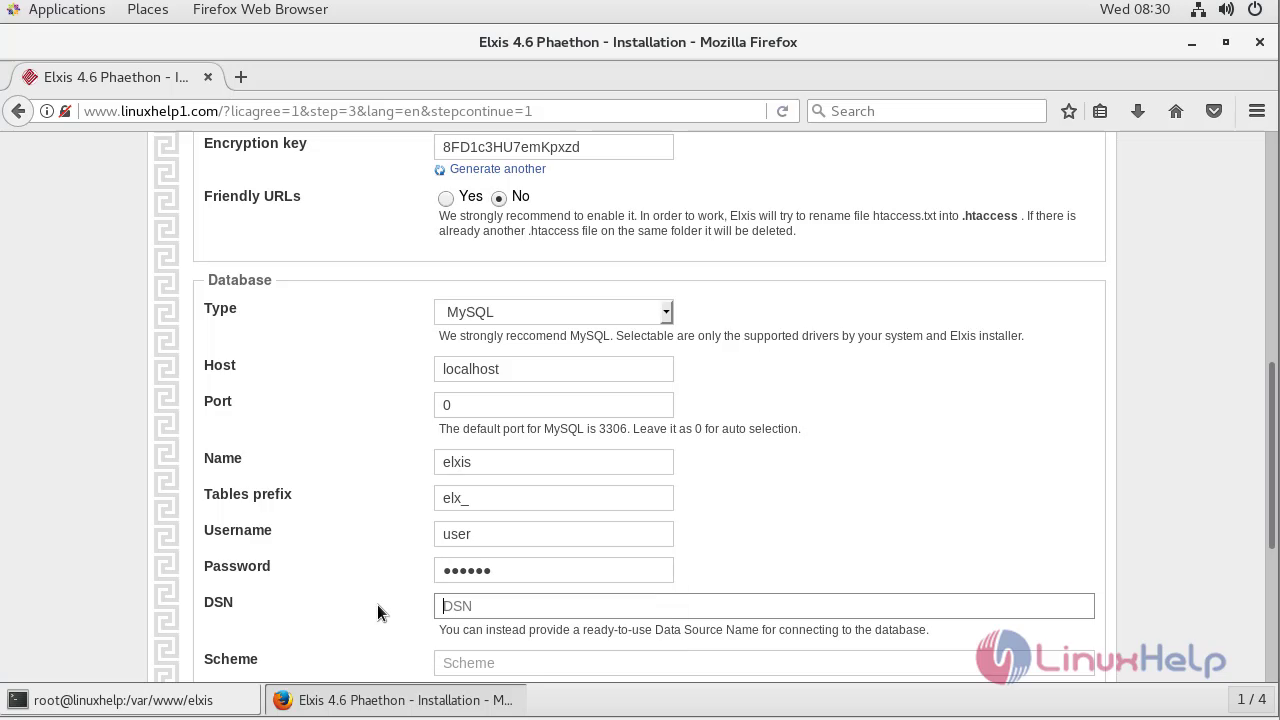
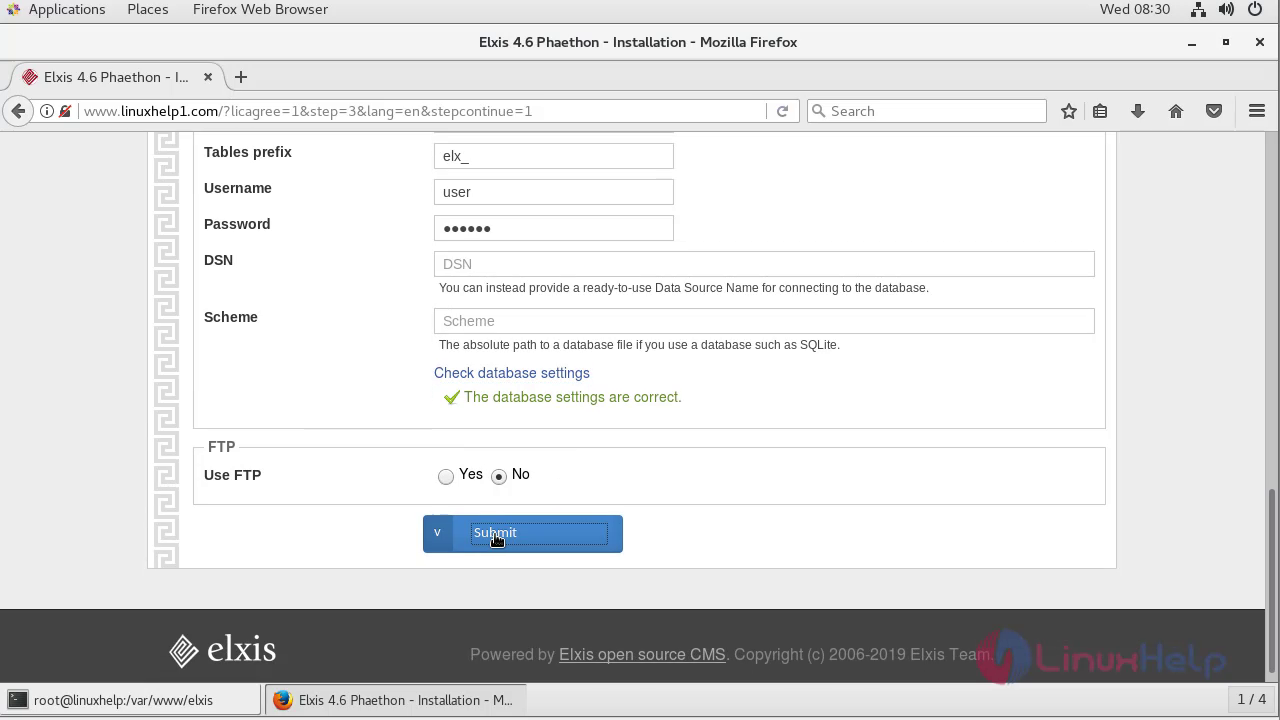
Enroll the Administrator account details by setting the username and password
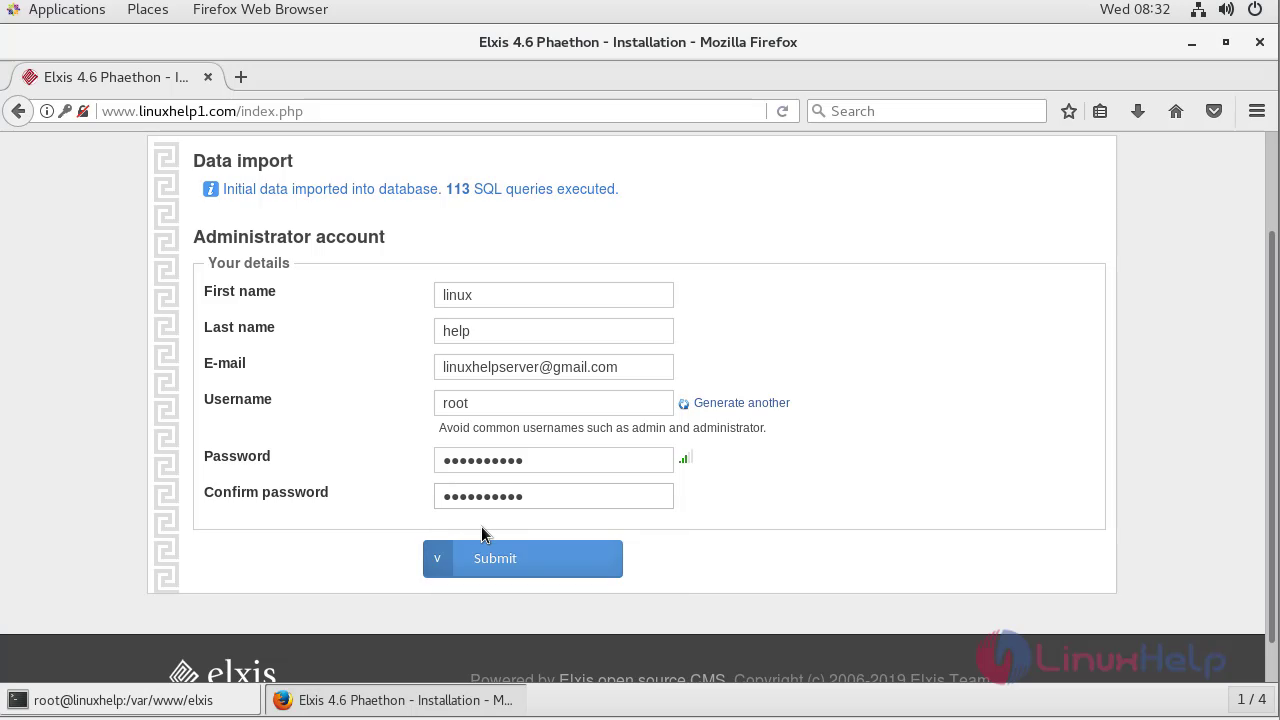
Copy the Configuration file configuration.php into the root folder of elxis by creating a new file
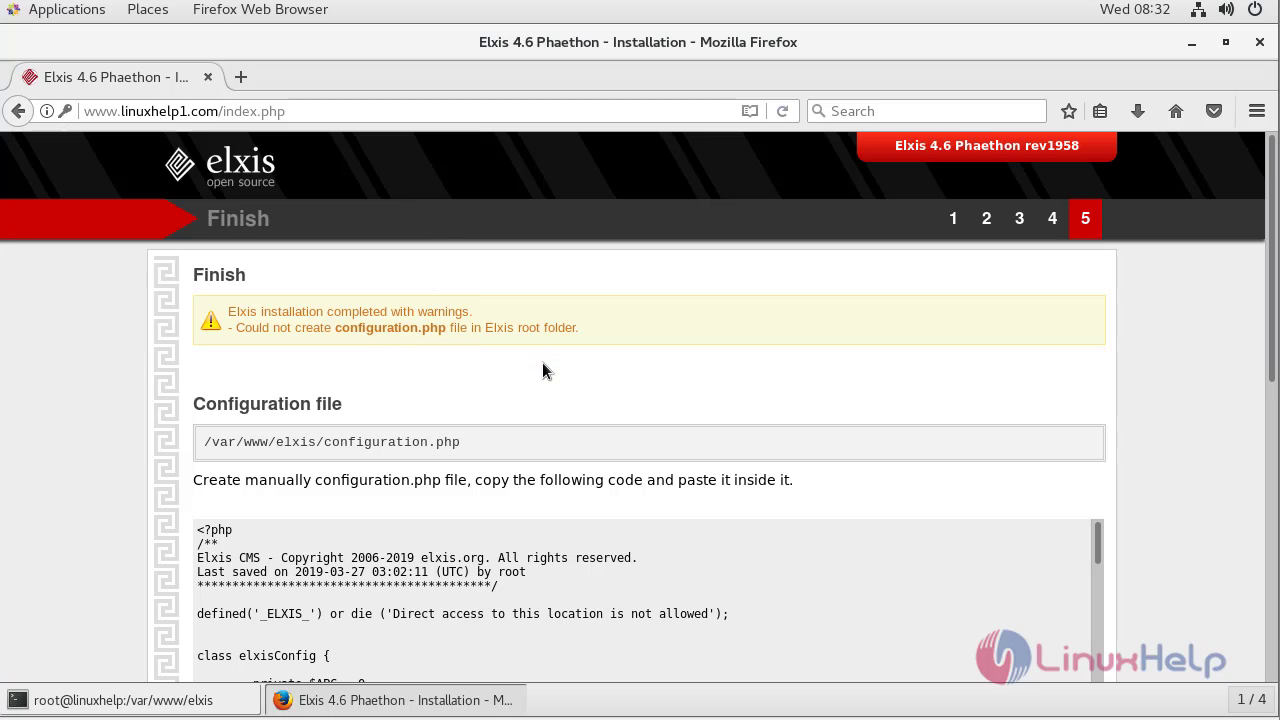
Login the credentials and access the elxis CMS On CentOs 7.5.


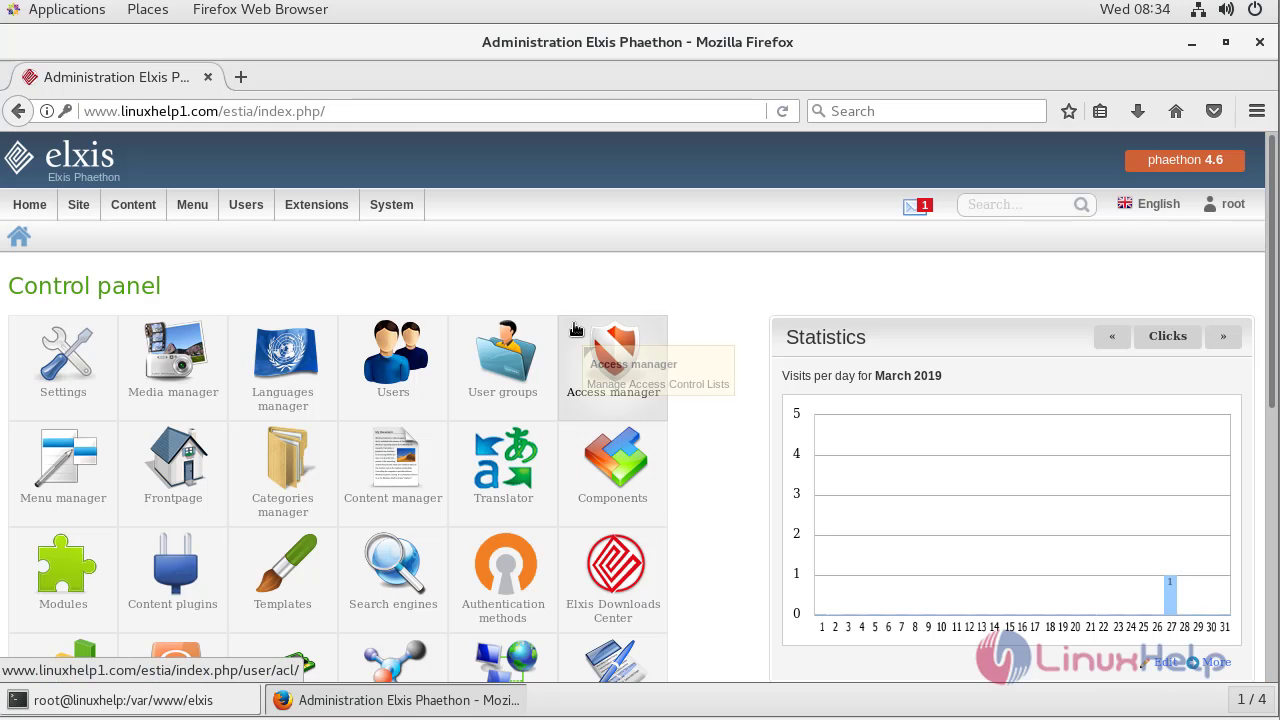
Thus,Installation Of Elxis CMS 4.6 On Centos 7.5 comes to end.
Comments ( 0 )
No comments available